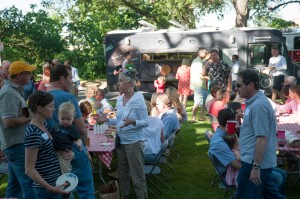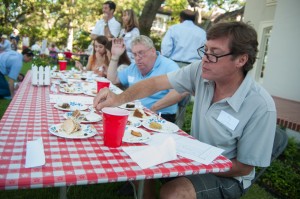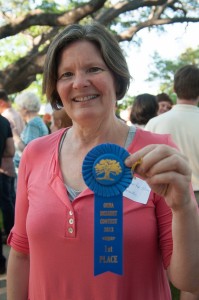The Austin History Center has compiled an archive of the family papers of our founding family. The description of the contents is interesting!
PEASE-GRAHAM-NILES FAMILY PAPERS, 1826-1992 AR.2000.01 1702 ITEMS SCOPE AND CONTENT NOTE
Correspondence; financial, legal, and business documentation; photographic and printed materials; creative works; ephemera; and objects are included in the 1702 items that make up the Pease-Graham-Niles Papers (1826-1992). The bulk of the material centers on the Graham and Harman families (1901-1992), but a great number of letters from earlier Pease family members fill out the collection.
The first subgroup (1 item) contains a photocopy of the biographical sketch of Governor E. M. Pease (1812-1883) published in Indian Wars & Pioneers of Texas and includes notes citing deeds in Bastrop, Texas.
The next three subgroups consist of letters received by Christiana Griswold Niles (3 items), Juliet Niles (1811-1903, 143 items), and Lucadia Christiana Niles Pease (1813- 1905), which were sent to the Niles home in Connecticut. The largest number of letters was sent from Lucadia to her sister Juliet (96 items). These letters describe the day-today activities of the family, especially the children. Lucadia wrote in 1869 regarding the ongoing debates of the State Constitutional Convention and mentioned enclosing a speech by a Texas woman on women’s suffrage for Juliet’s reference. Also present is a rare personal letter from Gov. Pease written to his sister-in-law when his daughters were ill and Lucadia was recovering from an injured finger and could not write.
The fourth subgroup comprises the records kept by Lucadia and Julia Pease while caring for the Graham children and managing the Pease investments. The largest series contains financial records (171? items), which deal with the investments and properties of the Pease family. Letters received (56 items) include letters to Julia and Lucadia from family and friends. Included are letters from Marshall Graham and R. Niles Graham while away at school, as well as from Pease and Niles relatives. Letters from Lucadia’s nephew Henry Ladd (4 items) contain an account of the 1893 fire in Austin which destroyed the Booth Building owned by Lucadia. Records related to some of Julia’s charity and social activities form another series and include groups such as the Charity Hospital (3 items), Daughters of the Republic of Texas (5 items), the Women’s Auxiliary of the Young Men’s Christian Association (3 items), Vassar College alumnae (7 items), and letters received from Elisabet Ney concerning the formation of a fine arts committee (2 items). Numerous purchase orders and receipts are in the Household Receipts series (43 items) and reflect the spending habits of the household from furnishings to clothing. The legal matters subgroup includes records related to an attempt to have taxes paid in 1866 by the Harris & Pease law firm refunded. Finally, an undated visiting book which includes the names of household visitors is present.
The Julia Maria Pease subgroup (24 items) contains miscellaneous bills, letters received, and notes of Julia’s after her mother’s death in 1905. The Graham Family Papers sub-group (1901-1992, 451 items) is arranged in seven series named for family members: R. Niles Graham, Anita Goeth Graham, Mr. and Mrs. R. Niles Graham, Marshall P. Graham II, Thomas A. G. Graham, Marshall and Thomas Graham, and Mary Harriet Graham. The Graham Family Papers document the Grahams’ business affairs, interests, activities, finances, education, travels, sense of humor, and relationships with family and friends.
The largest series with 322 items (1901-1955) is that of R. Niles Graham. His correspondence reveals a man popular with friends and business associates and much loved by his family. Some letters received by R. Niles Graham mention Woodlawn, his family home. Other correspondence records his strong interest in genealogy. Three documents in the Infield Petroleum subseries reveal his involvement in the oil business during the 1920s, but a much larger bulk of documents about Infield can be found in the first group of Pease-Graham-Niles Papers accessioned by the Austin History Center. The contents of R. Niles Graham’s wallet has been kept together in a subseries. R. Niles Graham kept an association with Trinity College and the Epsilon Chapter of the Delta Psi fraternity throughout his life as evidenced by correspondence in the Trinity College subseries. An photograph of R. Niles and his fraternity brothers has been removed to the Oversize Photo Archives.
R. Niles Graham’s personality shines through in the loving letters he wrote to his wife, Anita, while Mr. Graham traveled around Texas for his oil business. These letters (1911-1920, 61 items) are contained in the Anita Goeth Graham series (1911-1953, 93 items). This series also documents Anita Graham’s work for the blind and her close relationship to her family. Especially rich sources of information are her address and birthday books, which are heavily annotated and packed with enclosures. The Mr. and Mrs. R. Niles Graham series (1917-1966) consists of 18 items that are mainly invitations for social events. Mary Harriet Graham’s series is composed of a single item, a book recording those who attended her funeral in Austin in 1992.
The Marshall P. Graham II series (1929-1955, n.d., 8 items) includes a letter that he sent to his father about legal matters and a letter that he received from Walter E. Long about his mother, Anita Graham, along with a school brochure and dance card. The Graham-Lundgren subseries within the Thomas Graham (1917-1955, n.d., 8 items) series shows that Thomas had a business as an insurance agent. A single card from “Santa” (n.d.) in the Marshall and Thomas Graham series reveals the warmth and sense of humor shared by the family.
A subgroup of papers (1826-1987, 363 items) represents the Harman family. Three-quarters of the documents pertain to the life of Julie Anita Graham Harman (1923- 1987). Items concerning her education reveal that Julie liked to write poetry as a young schoolgirl. Assorted materials (1826-1947, n.d.) include an autograph book dating from 1826 which belonged to Julie’s Great Great Aunt Juliet Niles, and was passed down to Julie and her daughter Margaret by R. Niles Graham. Anita Goeth Graham sent numerous letters (1945-1950) to her daughter, Julie, while Julie and the rest of the Harman family were living in Virginia, in which Anita relayed news from Austin and shared tips on cooking.
The subseries titled “Organization Affiliations and Civic Activities” (1950- [1958]) provides insight into Julie’s service to the Austin community. In addition to several other groups, Julie was especially active in the Volunteer Council for the Austin State Hospital where she designed activities to brighten the lives of “crippled children.” Documents relating to Julie Harman’s membership in the Texas chapter of the Colonial Dames of America include a creative work about the restoration of the Neill Cochran House and photocopies of articles gathered in researching how the Colonial Dames of Texas contributed to the naming of the Official Flower of the State of Texas, the bluebonnet. Also included are copies of an article written by Ethel Mary Franklin [Smith], who was Julie’s father’s cousin, a fellow Colonial Dame, and a celebrated citizen of Austin.
While a student at the University of Texas, Julie was a member of the Zeta Tau Alpha sorority. A sorority publication from 1954 includes an obituary for Julie’s mother, Anita Goeth Graham, also a member of the organization. Inserted into the publication are two items: a typewritten resolution in memory of Anita from fellow members of the Woman’s Auxiliary of the Good Shepherd Church of Austin, and an undated manuscript in Anita’s hand.
Julie and James married on April 20, 1945. Julie kept a journal of wedding preparation activities. The couple’s social life and the family’s church involvement are reflected in the records contained in the Mr. and Mrs. James Harman series (1938-1977, n.d., 44 items). James’ career in journalism is documented in the James William Harman series (1937-1987, n.d., 24 items). The series pertaining to Margaret and Douglas Harman ([1946]-1966, 23 items) includes mainly printed materials from their childhood and teen years.
The subgroup named “Family Photographic Materials” (1907-1991, n.d.) includes photographic prints (173 items), framed photographs (2 items), and color slide transparencies (6 items). The bulk of the photographs dates from 1935 to 1938. Oversized photographic items in this subgroup are several loose prints (3 items) and a large framed photograph of Ethel Mary Franklin Smith (1 item), cousin of R. Niles Graham. An undated carte de visite featuring a portrait of Dewitt C. Baker, Ms. Smith’s grandfather, may be the oldest photograph in the body of materials. A panoramic photograph depicts Douglas Harman as a member of the Austin High School Graduating Class of 1966. Two photograph albums belonging to Julie Anita Graham, as well as 10 pages from a disbound photo album, are part of this subgroup. A large number of the images depict the Graham family at Woodlawn. Most frequently pictured is Julie Anita Graham. All of these items have been relocated from the family papers to be housed in appropriate collections. Some loose prints located in an envelope in one album have been separated from the album and integrated with the other loose prints.
A subgroup of materials pertaining to the Woodlawn Estate (ca. 1920-1985) includes printed materials, letters, creative works, and photographic materials (117 items). A publication about the architect of the mansion, Abner Cook (1814-1884), includes an essay by Julie Anita Graham Harman. An article titled “So Big Texas,” which appeared in National Geographic Magazine (June 1928), featured a photograph of the Woodlawn home. A print created for the article is part of the photographic materials, in addition to nitrate negatives depicting interior and exterior views of the mansion as well as black and white photographic prints of the estate grounds covered in snow and color slides of the estate in the 1950s. As above, photographs of the Woodlawn Estate have been separated and stored with the photography archives.
Numerous three-dimensional objects belonging to several members of the Pease- Graham-Niles family (1940, n.d., 22 items) are arranged and stored together. A slate writing tablet is inscribed with the name “Carrie”; it is not known whether it originally belonged to Carrie Augusta Pease or Carrie Margaret Graham Cruseman. Most of the objects belonged to R. Niles Graham.
Provenance This accession is the third body of materials representing the Pease-Graham-Niles family received by and housed at the Austin History Center. While two prior accessions (FP A.1 and AR.1998.07) overlap in time with this one and are arranged differently, consulting them is recommended in order to reach a fuller understanding of the family. Items in the Christina Griswold Niles, Juliet Niles, and Lucadia Christiana Niles Pease subgroups were likely among the documents R. Niles Graham brought to Austin from relatives in Connecticut.
Records kept by Lucadia and Julia Pease were originally maintained by carefully folding the papers into a standard length-wise size and marking the subject, usually the name of the sender, on the backside. These documents were received by the Austin History Center with a folio marked “1893 Correspondence,” although the papers found with the folio date from 1888-1896. It was not apparent that any order was used to arrange the documents, but the labels that Lucadia and Julia created have been maintained and are grouped in similar subject units.



